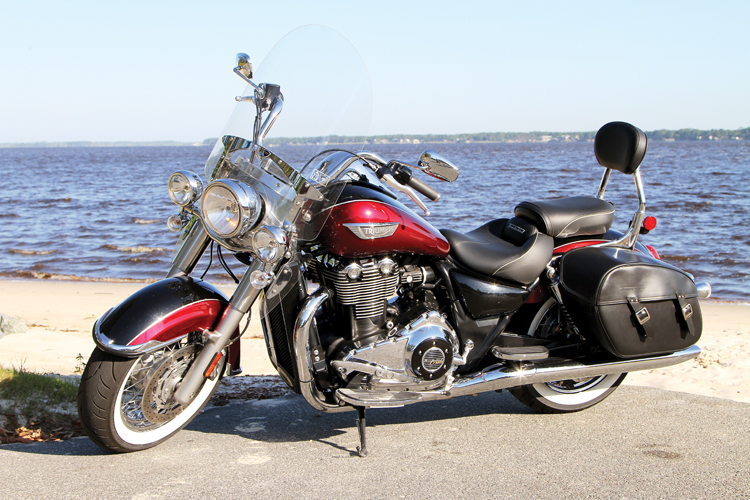Review: 2014 Triumph Thunderbird LT

For a British bike, the Thunderbird LT looks awfully American. Not that that’s a bad thing; it’s beautiful with its two-tone paint, whitewall tires, and abundance of chrome. Unlike the Thunderbird Storm and Commander, the LT ditches the twin headlight setup that’s a dead giveaway for a Triumph in favor of a large single headlight flanked by smaller running lights on either side. This three-light arrangement is so similar to other brands that many people had to be close enough to read the Triumph badge before realizing it was different. And different it is. Though Triumph is proud to point out that the 1,699cc power plant is the largest parallel twin ever built, the feeling from the rider’s seat is of a motorcycle that’s far more nimble than it has any right to be. With a dry weight of around 750 pounds, this is a substantial motorcycle. Yet it doesn’t feel heavy. And I’m not talking about the moto-journalist cliché, “The pounds melt away as soon as you get it moving,” either. Even at slow speeds, the LT just feels like a smaller motorcycle than it actually is. Being that this tour was a bit short on curves, I found myself really wishing for a nice twisty stretch when on the Triumph.
The LT (which stands for Light Touring) differentiates itself from the rest of the Thunderbird lineup by offering a more tour-friendly setup. This includes a large, detachable windscreen, leather saddlebags, 16-inch wire spoke wheels, and a stiffer rear spring. The result is a bike that’s pleasurable over long distances. The windshield does its job admirably by keeping a nice clean bubble of air around the rider while preventing literally thousands of Floridian insects from completing their kamikaze mission. The saddlebags are quite roomy and come with waterproof lining bags, which is a nice touch. The seating position is what I would call a milder take on the traditional cruiser. Your feet are placed slightly forward with your arms at a natural angle. I found the T-bird to be more comfortable than most other cruisers I’ve ridden, though mild back discomfort did set in after 150 miles or so.
Another area where the big Triumph impressed was with its braking. The three massive discs haul the equally massive motorcycle to a stop quickly and with absolute control. ABS is standard, and try as I might I couldn’t detect any pulses through the lever. There was one instance when an inattentive driver pulled out in front of me that I was very glad to have the Triumph’s brakes.
As is expected from such a large motor, power is prodigious though never overwhelming. Triumph claims 94 horsepower and 108 lb-ft of torque, and perhaps this is where the Thunderbird shows its heft, as acceleration is adequate though not overly exciting. One niggle I have with it is its exhaust note, which is rather anemic. If it were mine, the first upgrade would be a freer flowing exhaust with a more aggressive sound without it being overly loud and annoying of course.
In all, the Triumph Thunderbird offers performance that’s hard to fault in the heavyweight cruiser class. Its fit and finish are first rate, and its price (,699) undercuts most of the competition, which makes it a compelling value. Now, if they’d just stir back in a bit more British character.
